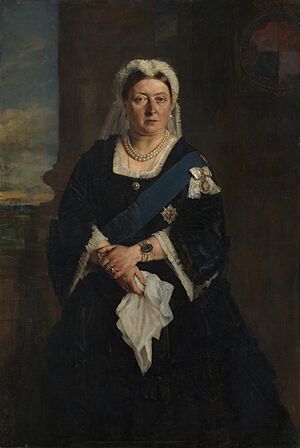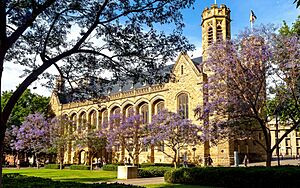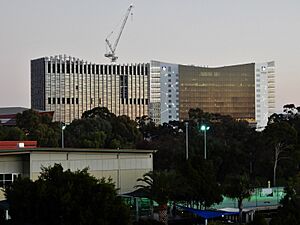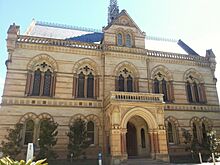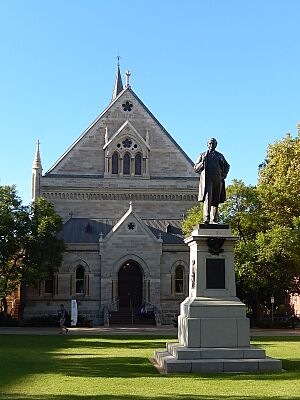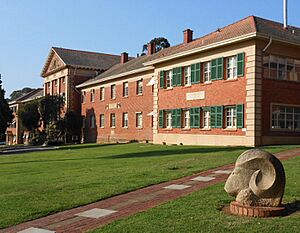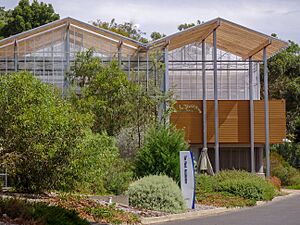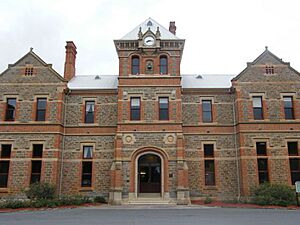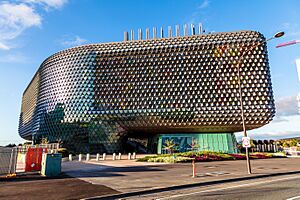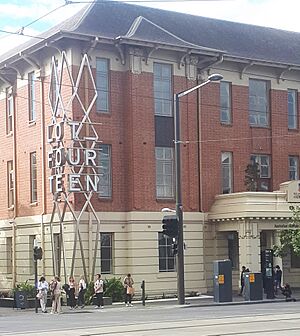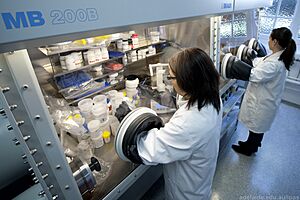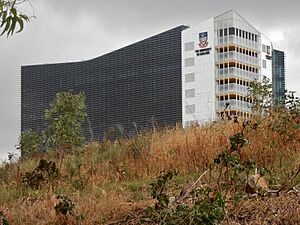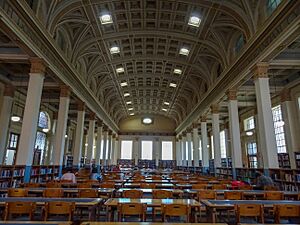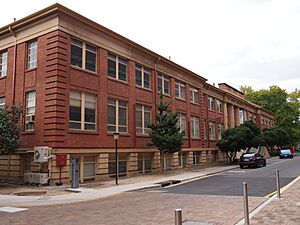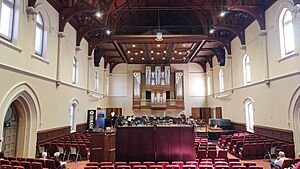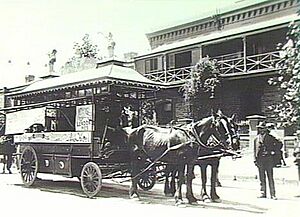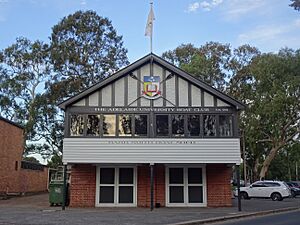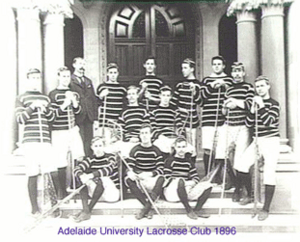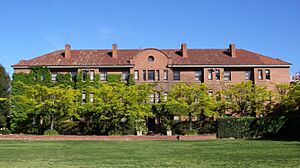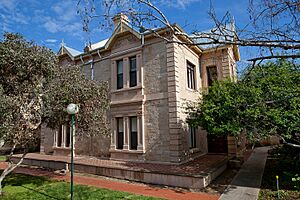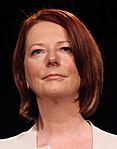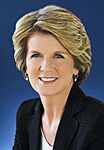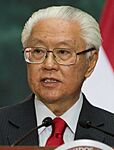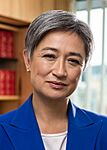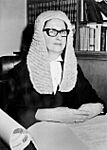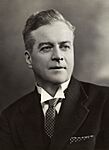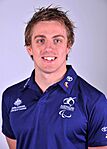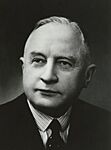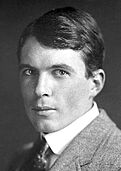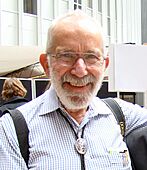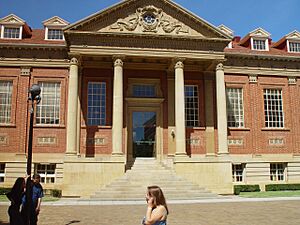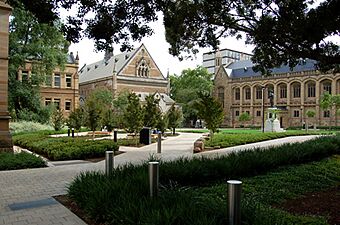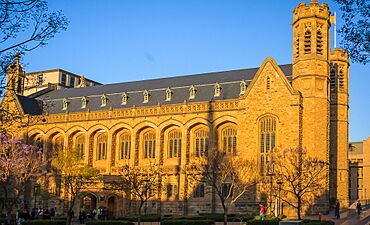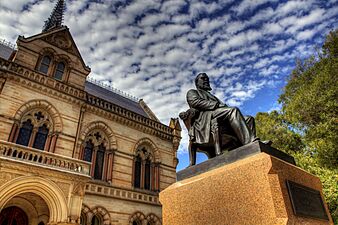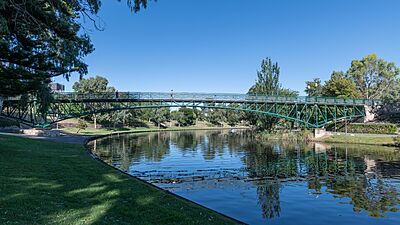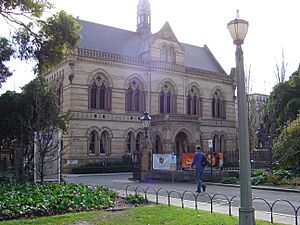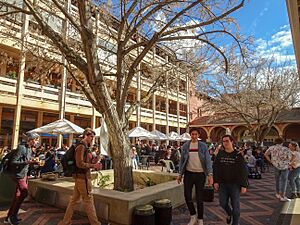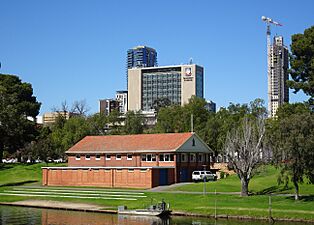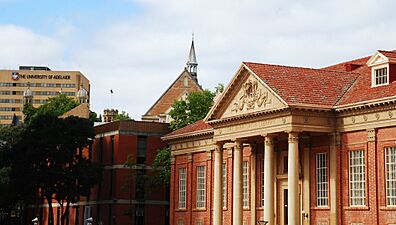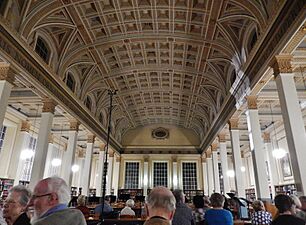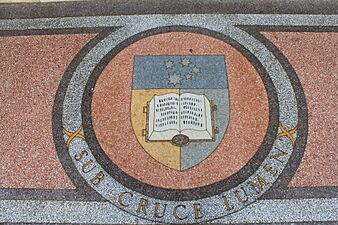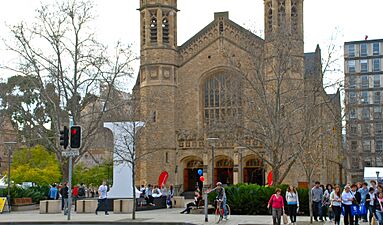University of Adelaide facts for kids
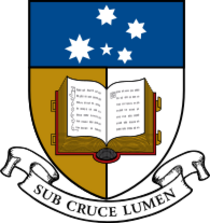
|
|
| Latin: Universitas Adelaidensis | |
|
Other name
|
Adelaide University |
|---|---|
|
Former name
|
Union College (1872–1874) |
| Motto |
Latin: Sub Cruce Lumen
|
|
Motto in English
|
"The light (of learning) under the (Southern) Cross" |
| Type | Public research university |
| Established | 6 November 1874 |
| Accreditation | TEQSA |
|
Academic affiliations
|
|
| Endowment | A$393.4 million (2023) |
| Budget | A$1.09 billion (2023) |
| Chancellor | Catherine Branson |
| Vice-Chancellor | Peter Høj |
|
Academic staff
|
1,700 (2023) |
|
Administrative staff
|
1,978 (2023) |
|
Total staff
|
3,678 (2023) |
| Students | 30,279 (2023) |
| Undergraduates | 19,493 bachelor (2023) |
| Postgraduates | 7,962 coursework (2023) 2,362 research (2023) |
|
Other students
|
772 (2023) |
| Address |
North Terrace
,
,
,
5001
,
|
| Campus | Urban and regional with multiple sites |
| Colours | Black White |
| Nickname | The Blacks |
|
Sporting affiliations
|
|
| Mascot | Gus the Black Lion |
 |
|
The University of Adelaide is a public research university located in Adelaide, South Australia. It was started in 1874, making it the third-oldest university in Australia. Its main campus in the city centre has many historic buildings made of sandstone, like Bonython Hall.
In 1881, Queen Victoria gave it a special permission, called a royal charter. This allowed it to become the second university in the English-speaking world to give degrees to women. The university is next to the Australian Space Agency and is part of the Adelaide BioMed City research area. It is also merging with the nearby University of South Australia. The new combined university will be called Adelaide University.
The university began at the Royal South Australian Society of Arts. Studies first took place at its Institute Building. The two universities, which together taught about three-quarters of the state's public university students, agreed to merge in mid-2023. The new university is expected to start operating by 2026.
The University of Adelaide has four campuses. Three are in South Australia: the main North Terrace campus in central Adelaide, the Waite campus in Urrbrae, and a regional campus in Roseworthy. There is also a study centre in Melbourne, Victoria. The university has three main groups of studies, called faculties, which are divided into many schools. It also has several research groups. In 2023, the university earned over $1.13 billion, with a lot of that money coming from research projects. It is a member of the Group of Eight, which is a group of top research universities in Australia.
Many famous people have studied at the university. These include the first female prime minister of Australia, two presidents of Singapore, the first astronaut born in Australia, and the first person to show nuclear fusion. Five Nobel Prize winners are connected to the university. This is one-third of all Australian Nobel winners. The university has also helped develop things like penicillin, space exploration, sunscreen, the military tank, Wi-Fi, polymer banknotes, and X-ray crystallography. It has also greatly influenced public life in South Australia.
Contents
- University History
- University Campuses and Buildings
- University Structure and Leadership
- Academic Programs and Research
- Libraries and Collections
- Museums and Collections
- Other University Divisions
- Student Life
- Notable People
- Gallery
- Tram Stop
- See also
University History
How the University Started
The university's story began with Union College in 1872. This college aimed to educate Protestant ministers who previously had to travel to the United Kingdom. The college taught science, maths, English, and religious studies. They asked Walter Watson Hughes, a wealthy farmer, for money to create a university. In 1872, the Adelaide University Association was formed to manage this new university.
The University of Adelaide was officially started on November 6, 1874. It was named after its founding city, which was named after Queen Adelaide. The South Australian parliament passed The Adelaide University Act of 1874 and gave the university a piece of land. In 1881, Queen Victoria granted a royal charter, allowing women to earn degrees. Early supporters, many of them from Scotland, gave large amounts of money to help the university grow.
Walter Hughes and Thomas Elder, another Scottish farmer, each donated £20,000 to start the university. At first, the university used the South Australian Institute Building. Later, the University Building was constructed. Thomas Elder left another £65,000 in his will, with £20,000 for the Elder Conservatorium of Music. Other donors included William Mitchell, a philosopher who taught and served as a leader. The University Building was later renamed the Mitchell Building in his honor.
The university was meant to be a place for "sound learning" open to everyone. Its first class, a Latin lecture, began in March 1876. The first leader was Richard Hanson, and the first vice-chancellor was Augustus Short. The first student to graduate was Thomas Ainslie Caterer in 1879. In 1882, it was the first Australian university to offer science degrees. Its law school started in 1883, medical school in 1885, and business school in 1902. These schools trained many of South Australia's first business people, lawyers, doctors, and politicians.
Another early supporter, Robert Barr Smith, wanted education to be available to all students. He donated £9,000 for books for the university library and £500 for radiation research. This research was done by Lawrence and William Henry Bragg, who later won a Nobel Prize in Physics.
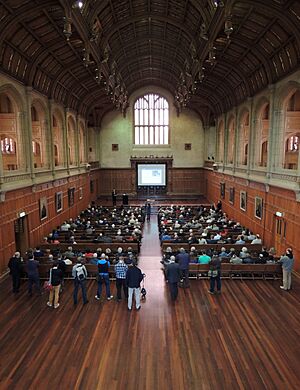
Bonython Hall, the university's main hall, was built in 1936. John Langdon Bonython, a newspaper owner, donated over £50,000 for it. The hall is used for graduation ceremonies and other events. It was designed in a Gothic Revival architecture style, like old European universities.
The University of Adelaide was the third university in Australia. The first two, in Sydney and Melbourne, only taught men. Adelaide allowed women to study alongside men from the start. In 1881, it became the second university in the English-speaking world to formally accept women equally, after the University of London. This led to many important achievements for women's education.
In 1991, the university opened two more campuses outside the city centre: Waite and Roseworthy. The university had already been at the Waite site since 1924. The Roseworthy campus was formerly an independent agricultural college that merged with the university.
Merging with the University of South Australia
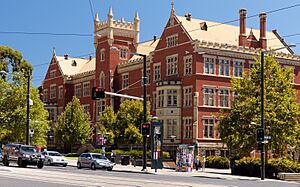
The University of South Australia is the state's third public university. It grew from the former South Australian Institute of Technology. This institute merged with other colleges to form the University of South Australia. It has campuses next to the University of Adelaide, and in Mawson Lakes, Magill, and Whyalla. Over time, it became the largest university in the state by student numbers.
In June 2018, the University of Adelaide and the University of South Australia started talking about merging. This idea was called a "super uni." However, the merger was stopped in October 2018 because the University of South Australia felt it wasn't the right time. Later, it was found that disagreements over who would lead the new university caused the talks to fail.
In early 2022, the idea of a merger came up again. The new state government suggested creating a special group to look into a merger between the state's three public universities. This was to help stop students from leaving for universities in other states and to attract more international students. After Peter Høj, a supporter of the merger, became the University of Adelaide's vice-chancellor, both universities agreed to consider merging again. They started a study to see if it was possible. Flinders University, the third public university, chose not to join the talks.
The two universities agreed to merge on July 1, 2023. They worked with the South Australian Government. The main reason for the merger was to make a bigger university that could rank higher, get more research money, and help the state's economy. By combining their skills and money, they believed they could be stronger.
In November 2023, a law was passed to create the new university, named Adelaide University. This name was already used informally for the University of Adelaide. On January 15, 2024, they applied for permission to offer courses. This was approved on May 22, 2024. Students starting from 2025 will get degrees from Adelaide University. Students who started before 2025 can choose to have the old university names on their degrees. The new university is expected to start operating by January 2026. It is predicted to have 70,000 students and contribute about $4.7 billion to Australia's economy each year.
University Campuses and Buildings
Adelaide City Campus
The main campus is on North Terrace in the Adelaide city centre. It is next to the Art Gallery, South Australian Museum, and State Library. The Mitchell Building, built in 1882, is the oldest building on campus. It was renamed in 1961 after William Mitchell. The Barr Smith Library is the main library here. The campus is planned to merge with the University of South Australia's nearby campuses to form the Adelaide City campus.
Bonython Hall, used for graduations, is a famous building facing the terrace. It looks like the Great Hall of the University of Sydney and old European universities. Between Bonython Hall and the Mitchell Building is Elder Hall. This is a large concert hall used by the Elder Conservatorium of Music. Both halls have big organs.
The university also has the Scott Theatre, Little Theatre, and College Green. The Scott Theatre is the largest lecture hall and hosts performances. The Little Theatre is used for plays. The College Green is a lawn area by the River Torrens where social events are held.
The Napier and Ligertwood Buildings were built after the Jubilee Exhibition Building was taken down in 1962. They are named after former leaders. The Mawson Building, named after explorer Sir Douglas Mawson, was finished in 1953. The Tate Museum is in this building.
Other important buildings include the Ingkarni Wardli Building and the Braggs Building. The Braggs Building, named after two Nobel Prize winners, has many science research facilities. The Adelaide University Footbridge, built in 1937, crosses the River Torrens. It is a popular spot for "love locks."
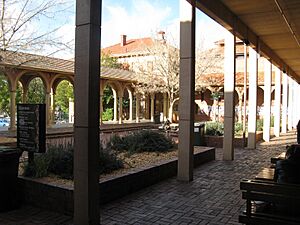
The Adelaide University Union redevelopment created important buildings between 1967 and 1975. This includes Union House and the Cloisters. The Adelaide University Union Cloisters were built in 1929 as a war memorial for university members who died in World War I.
The university also has a presence at Lot Fourteen, a technology area that hosts the Australian Space Agency. It also runs the National Wine Centre. The Adelaide Health and Medical Sciences Building is part of the Adelaide BioMed City area, surrounded by the South Australian Health and Medical Research Institute and the Royal Adelaide Hospital. This building, finished in 2017, is used for health and medical teaching and research.
Waite Campus
The Waite campus focuses on agricultural science, viticulture (grape growing), oenology (wine making), plant breeding, and food research. It is in Urrbrae, on land donated by Peter Waite. The Waite Research Precinct has several research centres.
The Waite Agricultural Research Institute started in 1924. It now produces about 70% of Australia's research in grape growing and wine making. It also created about 80% of the cereal types used in southern Australia. A Soil Research Centre was founded in 1929. In 2010, The Plant Accelerator, a large research facility, was opened here.
Other groups like the South Australian Research and Development Institute and Commonwealth Scientific and Industrial Research Organisation are also at this campus.
Urrbrae House, built in 1891, is now a museum. It was the home of Peter and Matilda Waite. The campus also has the Waite Arboretum, a tree museum with over 2,500 tree types. The Waite Conservation Reserve protects native plants and wildlife.
Roseworthy Campus
Located north of the city, the Roseworthy campus has 16 square kilometers of farmland. It is a major centre for agricultural research and veterinary sciences. It was originally the Roseworthy Agricultural College, Australia's first agricultural college, started in 1883. The Roseworthy College Hall, built in 1884, is now the student hub. Its clock tower got a clock in 2003, after being empty for over 120 years.
After the merger, the campus focused more on dryland agriculture and animal production. It also became home to South Australia's first veterinary science training program in 2008. The Veterinary Science Centre has teaching facilities and a public veterinary clinic. In 2013, the Equine Health and Performance Centre opened for horse care.
The Memorial Chapel, built in 1955, remembers students who died in wars. It has a statue of a soldier and an organ donated by a student's mother. A time capsule from 1976 is near the chapel and is expected to be opened in 2026.
In 2021, the Roseworthy Solar and Energy Storage Project opened. It has a solar farm that produces 42% of the campus's energy.
University Structure and Leadership
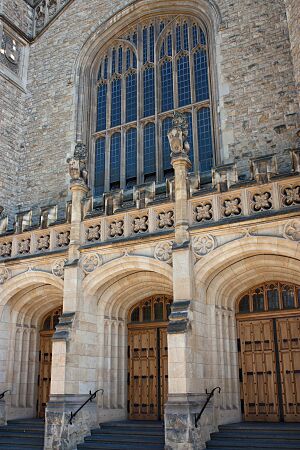
Study Areas and Departments
The university organizes its teaching and research into three main groups called faculties. Each faculty has several schools, departments, and institutes. The faculties were recently updated in 2022. The University Council is in charge of setting up these faculties and departments.
- Faculty of Health and Medical Sciences includes schools for dentistry, medicine, nursing, allied health, biomedicine, psychology, and public health.
- Faculty of Sciences, Engineering and Technology includes schools for agriculture, architecture, biological sciences, chemical engineering, computer and mathematical sciences, electrical and mechanical engineering, physics, chemistry, earth sciences, and animal and veterinary sciences.
- Faculty of Arts, Business, Law and Economics includes schools for business, law, music, economics, education, humanities, and social sciences.

University Council and Leaders
The main group that runs the university is its Council. It manages daily operations, sets rules, and chooses the chancellor and vice-chancellor. The Council includes the chancellor, vice-chancellor, staff members, students, and other appointed members.
The chancellor is mostly a ceremonial role. It is currently held by Catherine Branson, a former judge. She became chancellor in May 2020. The current vice-chancellor is Peter Høj, a Danish biochemist. He started in February 2021. The vice-chancellor is the main administrative officer, meaning they manage the university's day-to-day work.
University Symbols and Identity
The university uses several symbols. Its logo is based on its coat of arms. It also has a flag and a ceremonial mace. The university's motto is Sub Cruce Lumen, which means "the light (of learning) under the (Southern) Cross." Other slogans include "seek light" and "make history." The university's branding is expected to change after the merger.
The university's coat of arms was given in 1925. It has been used on all degrees since then. The design shows an open book and stars representing the Southern Cross.
Many universities have ceremonial maces for graduation ceremonies. The University of Adelaide Mace was made of silver-gilt. It shows the coat of arms on a globe, with an open book and gum leaves. The mace is carried in front of the chancellor during ceremonies.
Academic Programs and Research
The university is part of the Group of Eight, a group of top research universities in Australia. It is also a member of the Association of Pacific Rim Universities. The university offers many free online courses through platforms like edX and FutureLearn.
Research and Discoveries
In 2023, the University of Adelaide received over $261 million for research. This money came from government grants, public sector research, and industry.
A report in 2018 found that 100% of the university's research was "at or above world standard." This means its research is very good compared to other universities globally.
Key Research Institutes
The university has many research institutes that work with other organizations and companies. Some important ones include:
Australian Institute for Machine Learning
The Australian Institute for Machine Learning (AIML) studies artificial intelligence and machine learning. It is located at Lot Fourteen. Started in 2018, it is the largest university-based machine learning research site in Australia. It is also a top global site for computer vision research.
AIML shares most of its research with the world. Its researchers use machine learning to help industries like farming, medical imaging, defense, and space exploration.
Defence and Security Institute
The Defence and Security Institute at Lot Fourteen researches defense and security topics. This includes robotics, autonomous systems, space exploration, artificial intelligence, and cybersecurity.
Institute for Photonics and Advanced Sensing
The Institute for Photonics and Advanced Sensing focuses on photonics (light science) and sensing technology. It is in the Braggs Building. This institute has 10 research groups and advanced manufacturing facilities. It has developed precise measuring tools used in many areas, including agriculture, defense, and health.
Institute for Sustainability, Energy and Resources
This institute researches sustainability, energy, mining, and resources. It has over 20 research centres. They study topics like mineralogy, geosciences, energy generation, and food production.
Robinson Research Institute
The Robinson Research Institute does medical research on fertility, pregnancy, and child health. It has over 45 research groups. They specialize in areas like biotechnology, genomics, immunology, and women's health.
South Australian immunoGENomics Cancer Institute
The South Australian immunoGENomics Cancer Institute (SAiGENCI) is a new cancer research institute. It received $80 million in funding from the government. It is located in the Adelaide Health and Medical Sciences Building.
Stretton Institute
The Stretton Institute, named after professor Hugh Stretton, started in 2020. It researches public policy issues. It focuses on topics like food policy, building future cities, climate change, and democracy.
Waite Research Institute
The Waite Research Institute focuses on agricultural science, viticulture, oenology, plant breeding, and food research. It is on the Waite campus. It produces a lot of Australia's research in grape growing and wine making. It also created many cereal types used in southern Australia.
University Rankings
The University of Adelaide is highly ranked. In 2024, it was ranked #95 globally (8th in Australia) in a combined ranking of top universities.
- In the 2024 Australian Financial Review Best Universities Ranking, it was ranked #5 in Australia.
- In the 2025 Quacquarelli Symonds World University Rankings, it was #82 globally (8th in Australia).
- In the 2025 Times Higher Education World University Rankings, it was #128 globally (7th in Australia).
- In the 2024 Academic Ranking of World Universities, it was #151–200 globally (8th in Australia).
- In the 2025–2026 U.S. News & World Report Best Global Universities, it was #99 globally (9th in Australia).
Student Success
Surveys show how students experience the university and how they do after graduating.
- In 2023, 83.8% of employers were happy with graduates from the university.
- In 2023, 75.1% of undergraduate students and 89.5% of postgraduate students found full-time jobs.
- In 2023, undergraduates rated their education experience at 78.1%, and postgraduates at 72.7%.
Admissions and Fees
The South Australian Tertiary Admissions Centre manages applications. Students can apply with high school certificates, college grades, TAFE qualifications, or test scores. Some courses, like medicine, have extra requirements.
Tuition fees for international students in 2025 range from $19,000 to $94,000 per year. Australian students may get government help to lower their fees. Students can also get government loans to pay for their studies. The university also offers scholarships.
The academic year has two semesters, plus optional summer and winter classes. There are also study weeks before exams.
Libraries and Collections
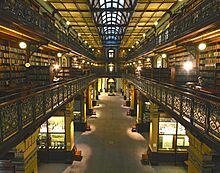
The university has four libraries across its three campuses. The largest is the Barr Smith Library on the main campus. The university also has online resources and subscriptions to academic journals. The State Library of South Australia is also next to the university.
Barr Smith Library
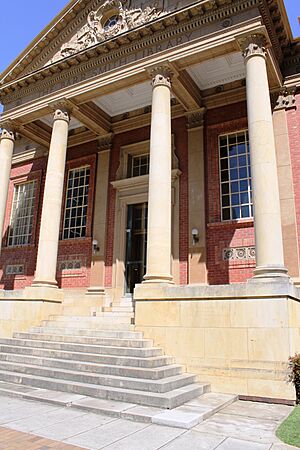
The Barr Smith Library is the third-oldest university library in Australia. It was named after Robert Barr Smith, who donated a lot of money for books. His family also gave more money and books later. The library building was designed in the Georgian Revival style, inspired by Kensington Palace in London.
The Barr Smith Reading Room is a special part of the library. It has oak floors, white pillars, and gold arches on the ceiling. The library also has a collection of rare books and university archives.
Sir John Salmond Law Library
Started in 1883, the Sir John Salmond Law Library has many legal books from Australia and other countries. It was renamed after John William Salmond, a former law professor.
Roseworthy Library
The Roseworthy Campus Library is on the Roseworthy campus. It started as the Tassie Memorial Library in 1920, named after a student who died in World War I.
Waite Woolhouse Library
The Waite Campus Library, also called the Woolhouse Library, is on the Waite campus in Urrbrae.
Museums and Collections
Tate Museum
The Tate Museum is one of Australia's largest geology museums. It has about 29,000 rocks and fossils, including meteorites. It was named after Ralph Tate, a botanist and geologist who started the collection in 1881.
In 1952, it moved to the Mawson Laboratories building, named after explorer Douglas Mawson. The museum also has items from Mawson's trips to the Antarctic. It has very old organisms, some from 550 million years ago, and parts of an asteroid that hit South Australia long ago.
Waite Historic Precinct
The Waite Historic Precinct includes the Urrbrae House museum, Waite Arboretum, and Waite Conservation Reserve. Urrbrae House was built in 1891 and was the home of Peter Waite. The Waite Arboretum is a tree museum with over 2,500 types of trees. The Waite Conservation Reserve protects native plants and animals.
Other University Divisions
Elder Conservatorium of Music
Started in 1883, the Elder Conservatorium of Music is Australia's oldest university music school. It offers studies in jazz, classical music, musical theatre, pop music, and music production. It is also home to the Australian String Quartet. The conservatorium hosts concerts and performances. Its first music professor was Joshua Ives. Ruby Claudia Davy was the first Australian woman to earn a doctorate in music in 1918.
The Elder Hall, used by the conservatorium, was built after Thomas Elder left money for it. It officially opened in 1900. The hall was used for graduation ceremonies before Bonython Hall was built.
National Wine Centre
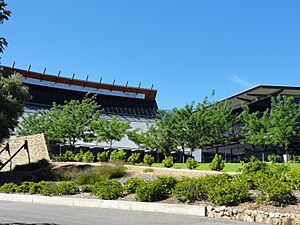
Located in the Adelaide Park Lands, the National Wine Centre offers some of the university's oenology (wine making) courses. Opened in 2001, it also has public displays about winemaking. Visitors can learn about wine technology and taste wines from Australia. The building is next to the Adelaide Botanic Gardens.
Student Life
Student Association
| YouX SRC Political Groups | |
|---|---|
| Structure | |
|
Political groups
|
|
| Footnotes | |
| Accurate as of 23 July 2024 | |
Founded in 1895, the Adelaide University Union, now called YouX, is one of Australia's oldest student unions. It represents students and offers many services. It is run by elected student officers. The union supports over 175 clubs and societies. These include the Adelaide University Sciences Association and the Adelaide Medical Students' Society.
In September 2024, YouX and the University of South Australia Student Association announced they plan to merge.
Annual Prosh Event
The student union organizes the yearly Prosh week. This event is inspired by old traditions where students would playfully challenge authority. The Procesh parade started in 1905. Students would make fun of local institutions. One famous prank involved hanging a Holden car from the Adelaide University Footbridge in 1971.

Since 1954, students have sold satirical newspapers called the Prosh Rag to raise money for charity. This newspaper, now part of the On Dit student magazine, often makes humorous comments about current events and people. The event has become less wild over time, partly due to students having more work and the rise of social media. Prosh week ends with a social event called Prosh After Dark.
Student News and Radio
On Dit, started in 1932, is Australia's second-oldest student-run print newspaper. It is independent from the university. It often publishes articles on national and global politics. Famous former writers include politicians Julia Gillard and Penny Wong.
The university also had its own official newspapers like Lumen. The university started Radio Adelaide, Australia's first community radio channel, in 1972. It operated until 2016. Adelaide University Student Radio, started in 1975, was Australia's oldest student-run radio program.
Sports and Athletics
Established in 1896, Adelaide University Sport has 37 sports clubs. Some clubs are even older than the association itself. Its motto is Mobilitate Vigemus, meaning "we thrive by mobility." Its colors are black and white, and its mascot is Gus, a black lion.
The Adelaide University Boat Club started in 1881. Its boat shed was donated by Robert Barr Smith in 1909. Several Olympians have been members, including Collier Cudmore, Australia's first rowing gold medalist in the 1908 London Olympics. The Adelaide University Lacrosse Club was founded in 1889 by future Nobel Prize winner William Henry Bragg.
These clubs helped start the Adelaide University Sports Association in 1896. This association became directly linked to the university in 2010 and was renamed Adelaide University Sport.
Student Housing
The university did not originally set aside land for student housing on its main campus. However, private colleges linked to the university were established.
St Mark's College was founded in 1925 by the Anglican Diocese of Adelaide. It was created to offer a college lifestyle similar to Oxford and Cambridge.
Aquinas College started in 1950 for men and became co-ed in 1975. St Ann's College started in 1947 for women and became co-ed in 1973. Lincoln College was founded in 1952 and became co-ed in 1973.
The university also manages its own student housing, including the University Village and Roseworthy Residential College.
Notable People
The University of Adelaide has many famous alumni, including students from colleges that merged with it.
- Notable alumni of the university include:
-
Julia Gillard
First female Prime Minister of Australia -
Andy Thomas
Aerospace engineer and first Australian-born astronaut -
Tony Tan
7th President of the Republic of Singapore -
Penny Wong
Current Minister for Foreign Affairs and senate leader -
Ong Teng Cheong
5th President of the Republic of Singapore -
Laura Margaret Hope
First female surgeon in Australia -
Mark Oliphant
Nuclear physicist and humanitarian -
Tirana Hassan
Executive director of Human Rights Watch -
Don Dustan
Former Premier of South Australia -
Guy Sebastian
Singer-songwriter and musician -
Lionel Logue
Speech and language therapist -
Edward Holden
Industrialist and founder of GM Holden
The university has greatly influenced public life in South Australia. It educated many of the state's first business people, lawyers, doctors, and politicians. It has also produced 117 Rhodes scholars and 168 Fulbright scholars. Five Nobel Prize winners are connected to the university, making up one-third of Australia's total Nobel laureates.
Famous alumni include Australia's first female prime minister Julia Gillard, Singaporean presidents Tony Tan and Ong Teng Cheong, the first Australian-born astronaut Andy Thomas, and the first person to show nuclear fusion Mark Oliphant. Other notable alumni are singer-songwriter Guy Sebastian, industrialist Edward Holden (who founded GM Holden), speech therapist Lionel Logue (who helped King George VI with his stammer), and Neil Weste (whose work helped develop wireless communications). Many Olympians and Paralympians, like Matthew Cowdrey, have also studied here. Current leaders include state premier Peter Malinauskas and national senate leader Penny Wong.
Women's Education Milestones
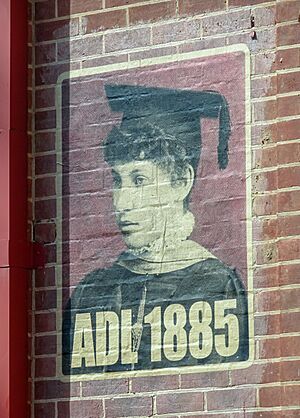
After Queen Victoria granted a royal charter in 1881, the university became the second in the English-speaking world to formally accept women into degree programs equally with men. This led to many "firsts" for women's education in Australia. The first female graduate was Edith Emily Dornwell in 1885. She was also the first person in Australia to get a Bachelor of Science degree. The university also graduated Australia's first female surgeon, Laura Margaret Fowler, in 1891. Ruby Claudia Davy was the first Australian woman to get a doctorate in music in 1918.
In 1914, the university was the first to elect a woman, Helen Mayo, to a university council in Australia. It is also the alma mater of Roma Mitchell, who was Australia's first female judge and the first female state governor. Australia's first female prime minister Julia Gillard also studied here.
Nobel Prize Winners
Physicist
Pharmacologist
Pathologist
Several Nobel Prize winners are connected to the university. Lawrence Bragg, an alumnus, won the Nobel Prize in Physics in 1915 with his father William Henry Bragg for their work on x-ray crystallography. He was the youngest Nobel laureate until 2014.
Howard Florey, a pharmacologist, shared the 1945 Nobel Prize in Physiology or Medicine for helping develop penicillin. J. M. Coetzee, a novelist and faculty member, won the Nobel Prize in Literature in 2003. Robin Warren, a pathologist who graduated in 1961, shared the 2005 Nobel Prize in Physiology or Medicine for discovering that peptic ulcers are caused by bacteria.
Gallery
-
Bonython Hall during sunset
-
Entrance to Bonython Hall
-
View across the River Torrens
-
Bonython Hall during autumn
Tram Stop
The university has two tram stops, University and City West. These connect the main campus to the Adelaide Health and Medical Sciences Building on North Terrace.
| Preceding station | Adelaide Metro | Following station | ||
|---|---|---|---|---|
| Art Gallery
towards Adelaide Entertainment Centre
|
Glenelg tram line | Botanic Gardens
Terminus
|
||
See also
 In Spanish: Universidad de Adelaida para niños
In Spanish: Universidad de Adelaida para niños
- List of universities in Australia
- University of Adelaide College - a private pre-university pathways college
- Elder Conservatorium of Music
- Roseworthy Agricultural College
- Education in Australia
- Barr Smith Library
- On Dit



